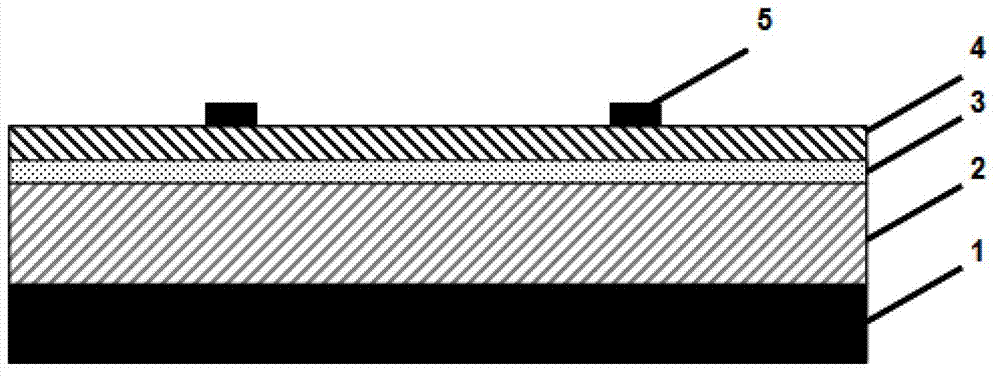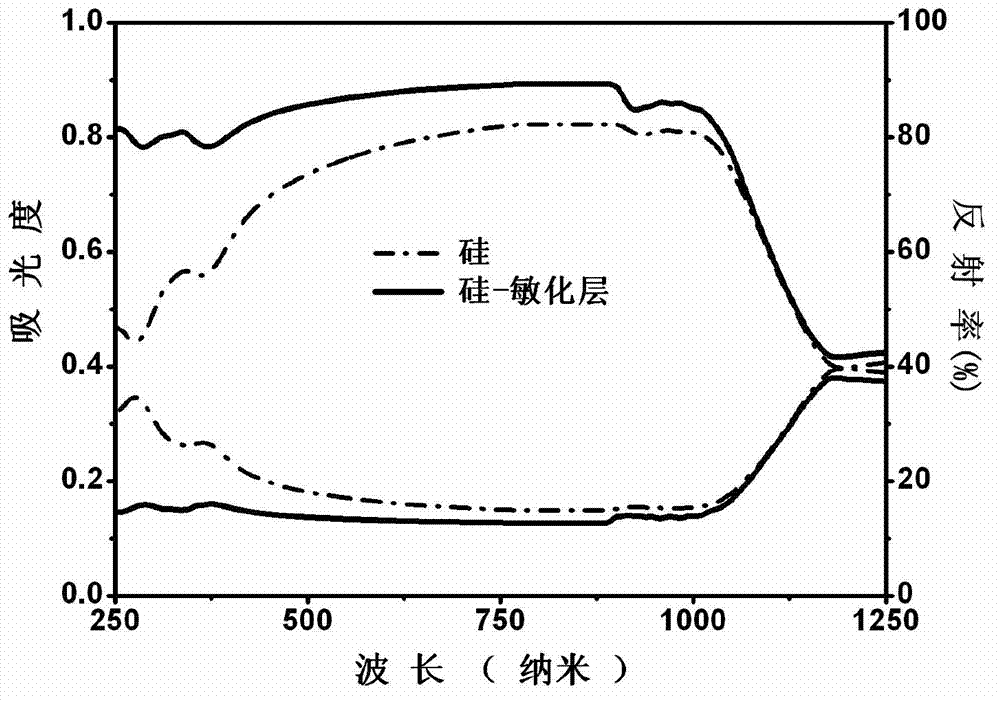Chemical vapor deposition preparation method of nanocrystal/quantum dot sensitized crystalline silicon battery cell
A technology of chemical vapor deposition and sensitization of crystalline silicon, applied in electrical components, circuits, climate sustainability, etc., can solve the problems of narrow energy band, high production cost, optical loss, etc. of single crystal silicon, and achieve strong absorption, Reduce damage, reduce the effect of surface reflections
- Summary
- Abstract
- Description
- Claims
- Application Information
AI Technical Summary
Problems solved by technology
Method used
Image
Examples
Embodiment 1
[0030] a) Prepare the cleaning solution according to the ratio of 28% ammonia water: 30% hydrogen peroxide: pure water volume ratio of 1:1:4, put the diffused monocrystalline silicon cell into the cleaning solution, ultrasonically clean it for 10 minutes, take it out, and wash it with pure water ;
[0031] b) Prepare an etching solution with a volume ratio of 40% hydrofluoric acid: absolute ethanol of 3:1, put the cleaned diffused monocrystalline silicon cell into the etching solution, perform ultrasonic etching for 5 minutes, take it out, and wash it with pure water;
[0032] c) Dip the corroded monocrystalline silicon cell in 0.5mol / L ammonium fluoride solution for 5 minutes and perform surface hydrogen termination treatment;
[0033] d) Put the hydrogen-capped monocrystalline silicon cells into a 0.1mol / L tin tetrachloride aqueous solution, immerse in ultrasonic for 5min, perform metal salt treatment, take them out, and put them into a vacuum drying oven;
[0034] e) Accor...
Embodiment 2
[0038] a) Prepare a cleaning solution according to the ratio of 28% ammonia water: 30% hydrogen peroxide: pure water volume ratio of 1:1:3, put the diffused polysilicon cell into the cleaning solution, ultrasonically clean it for 10 minutes, take it out, and wash it with pure water;
[0039] b) Prepare an etching solution with a volume ratio of 40% hydrofluoric acid: absolute ethanol of 1:1, put the cleaned diffused polysilicon cell into the etching solution, perform ultrasonic etching for 3 minutes, take it out, and wash it with pure water;
[0040] c) Dip the corroded polysilicon cell in 0.5mol / L ammonium fluoride solution for 3 minutes with ultrasound for surface hydrogen termination treatment;
[0041] d) Put the hydrogen-capped polysilicon cells into a 0.1mol / L tin tetrachloride aqueous solution, immerse in ultrasonic for 3 minutes, perform metal salt treatment, take them out, and put them into a vacuum drying oven;
[0042] e) According to the size of polysilicon cells (...
Embodiment 3
[0046] The preparation method of this example is the same as that described in Example 1, the difference is that in step b) the corrosion solution is prepared according to the ratio of 40% hydrofluoric acid: absolute ethanol volume ratio of 2:1, and the cleaned diffused single crystal Put the silicon cell into the etching solution, ultrasonically corrode for 15 minutes, take it out, and wash it with pure water.
PUM
| Property | Measurement | Unit |
|---|---|---|
| thickness | aaaaa | aaaaa |
Abstract
Description
Claims
Application Information
 Login to View More
Login to View More - R&D
- Intellectual Property
- Life Sciences
- Materials
- Tech Scout
- Unparalleled Data Quality
- Higher Quality Content
- 60% Fewer Hallucinations
Browse by: Latest US Patents, China's latest patents, Technical Efficacy Thesaurus, Application Domain, Technology Topic, Popular Technical Reports.
© 2025 PatSnap. All rights reserved.Legal|Privacy policy|Modern Slavery Act Transparency Statement|Sitemap|About US| Contact US: help@patsnap.com



